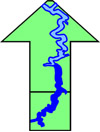

Saturday 11 January 2003
SENT VIA FAX
Congressman Alan B. Mollohan
2346 Rayburn House Office Building
Washington DC 20515-4801
RE: Lock Hours Information
Dear Congressman Mollohan:
We have been pursuing this lock hours issue since February 2000 when we first organized as the informal Upper Monongahela Committee for Better Boating. And, of course, the basic problem is money and political consensus.
We also are friends of the US Army Corps of Engineers (COE). We also understand that COE is always between a rock and a hard place, for two reasons. First, we don't envy COE managment in their quest to do their job, given they are straddling highly-polarized views as to the role of COE, eg, extreme environmentalism versus pragmatic uses of our nation's navigable rivers. Second, we also know that every president since Harry Truman (including our current President Bush) has tried to tone down congressional funding for COE projects. But!! Be it known we are on the side of Congress when it comes to deciding what we need in the way of projects and funds for our nation's navigable waterways!
We understand that the continued budget cuts over years for COE civil works programs forces the Pittsburgh District to curtail lock hours on our Upper Mon in WV. I won't belabor this point as we have consistently addressed the money problem, most recently in our Navigation Resolution mailing of 9 January 2003.
But, in addressing this issue for the Upper Mon, it would help if we all worked from the same basic information. I thus ask that you request this information from COE.
The Clean Air Act Amendments of 1990 perhaps have the most bearing on the decline of river commerce on our Upper Mon. This is borne out in my 19 February 2001 report, COMMERCE DECLINE ON UPPER MONONGAHELA THREATENS RECREATIONAL BOATING.
To further understand how this act affected our Upper Mon in WV, we need some more information.
Thus, starting with FY 1992, concerning the Upper Mon in WV, it would help to have Pittsburgh District budget information for FY 1992 through FY 2002. And, in addition, the Pittsburgh District's budget planning contingencies for FY 2003. It also would be very neat if this budget information re annual dollars could be presented in two ways. First, the appropriated funds for each FY. Then, also state these costs in dollars adjusted for inflation, using a base year, eg, FY 2002.
The Pittsburgh District information for each FY should be as follows: (1) Total budget for river operations; (2) Budget for the Monongahela; (3) Budget for Upper Mon in WV, broken into personnel costs and numbers of employees, other operating costs, normal maintenance costs, and, major refurbishment costs. Of course, any format that COE uses to provide this and perhaps other information, would be fine, provided we can easily discern these costs from their format.
We further need the Pittsburgh District's cost and manning estimate as to what it would take to ensure that the Morgantown lock remains open all day all year, and, restoration of the Hildebrand and Opekiska locks to being open all day all year. And, as a second option, reduced winter hours for Hildebrand and Opekiska, with full round-the-clock summer (1May - 31 October) hours. I ask that this information be based on FY 2003, which, of course, would also be most useful for FY 2004 budget planning.
Now, given all the budget squeezes, one wonders if our three Upper Mon locks are getting the maintenance and refurbishment they need. Thus, information is needed as to such deferred needs and costs for our three locks and dams. And, for any other needs on the Upper Mon in WV, eg, dredging.
We also need information re automation of lock chambers so that they may be remotely operated, since you have requested that Congress appropriate $5M for automation of Upper Mon lockages. I would like for COE to provide a bibiliography of reports re automation of lockages, as COE and the Europeans have researched this idea. And, I would like any reports that COE could provide, for free, or, purchase. And, who are the COE experts re lockage automation R&D?
Next, what innovative ideas are underway within COE for providing service on rivers impacted like our Upper Mon, and, the Upper Allegheny in PA? Our brethern in the River Navigation Coalition are aware of the Fox River approach in Wisconsin. But, I have been unable to find much information on this concept. And, is COE involved in other such innovative approaches?
Finally, we always hear about the "rules" governing how COE allocates river funds, and, sets lock hours. I think these rules are myths, and, thus, the District Engineers deal pragmatically with such matters given budget contraints. However, my specific questions here are: (1) What congressional legislation governs how COE is to evaluate the performance of locks, and, thus, set the operating hours, staffing, and maintenance for individual locks? (2) What directives from the Office of Management and Budget apply to lock performance evaluation, and, are these directives consistent and stable over time, or, do they constantly change? (3) Same as question (2), except substitute COE for OMB. And, (4), same as question (2), except substitute Pittsburgh District for OMB.
Congressman Mollohan, your help in getting this information will be most appreciated. With this information, we all can then develop a better understanding of Upper Mon navigation problems, and, thus, possible solutions. Hopefully, this information could be forthcoming before the end of February 2003. While this date may be too late to impact FY 2003 appropriations, it still can be used for supplemental appropriations sure to follow re federal expenditures for FY 2003. And, planning and budgeting for FY 2004, which starts 1 October 2003.
Sincerely,
Donald Strimbeck, Secretary
Upper Monongahela River Association, Inc.
cc: VIA FAX, Amy Tomer, Office of Congressman Mollohan, Morgantown WV, 304-292-3019 (FAX: 3027).
All LOCK HOURS email lists.